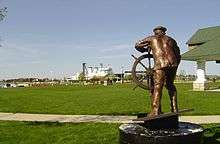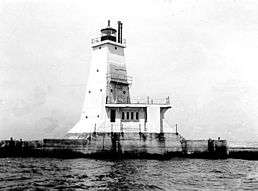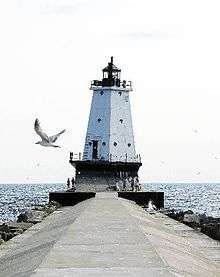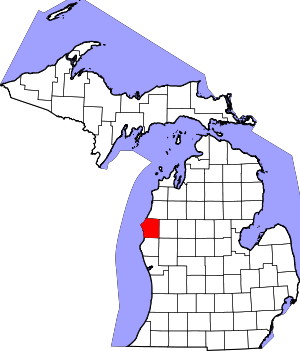Ludington, Michigan
Ludington (/ˈlʌdɪŋtən/ LUH-ding-tən) is the largest city and county seat of Mason County in the U.S. state of Michigan.[6] As of the 2010 census, the city population was 8,076.
Ludington, Michigan | |
|---|---|
| City of Ludington | |
Mason County Courthouse in Ludington | |
 Location within Mason County | |
 Ludington Location within the state of Michigan | |
| Coordinates: 43°57′25″N 86°26′40″W | |
| Country | United States |
| State | Michigan |
| County | Mason |
| Settled | 1847 |
| Incorporated | 1873 |
| Government | |
| • Type | Mayor–council |
| • Mayor | Steve Miller |
| • Clerk | Deborah Luskin |
| • Manager | Mitch Foster |
| Area | |
| • Total | 3.70 sq mi (9.6 km2) |
| • Land | 3.37 sq mi (8.7 km2) |
| • Water | 0.33 sq mi (0.9 km2) |
| Elevation | 591 ft (180 m) |
| Population | |
| • Total | 8,076 |
| • Estimate (2018)[4] | 8,137 |
| • Density | 2,396.4/sq mi (925.3/km2) |
| Time zone | UTC-5 (Eastern (EST)) |
| • Summer (DST) | UTC-4 (EDT) |
| ZIP code(s) | 49431 |
| Area code(s) | 231 |
| FIPS code | 26-49640 |
| GNIS feature ID | 0631201[5] |
| Website | Official website |
Ludington is a harbor town located on Lake Michigan at the mouth of the Pere Marquette River. Many people come to Ludington year round for recreation, including boating and swimming on Lake Michigan, Hamlin Lake, and other smaller inland lakes, as well as hunting, fishing, and camping. Nearby are Ludington State Park (which includes the Big Sable Point Light), Nordhouse Dunes Wilderness, and Manistee National Forest. Ludington is also the home port of the SS Badger, a vehicle and passenger ferry with daily service in the summer across Lake Michigan to Manitowoc, Wisconsin. Watching the Badger come into port in the evening from the end of the north breakwall by the Ludington lighthouse is a favorite local pastime.
Ludington has multiple golf and disc golf courses, attracting numerous players. In summer, the city hosts quite a few large events. Examples are one of the largest Gus Macker basketball tournaments (with 35,500 spectators), the Ludington Area Jaycees Freedom Festival (July 4), the Lakestride Half Marathon in June, and the West Shore Art League's Art Fair. As a result of its many attractions (based on AAA's 2005 TripTik requests), Ludington is the fifth-most-popular tourist city in Michigan, behind Mackinaw City, Traverse City, Muskegon, and Sault Ste. Marie.[7]
History
In 1675, Father Jacques Marquette, French missionary and explorer, died and was laid to rest here. A memorial and large iron cross mark the location. Recently there was a petition to remove this monument due to it involving religion. It is still being considered.
In 1845, Burr Caswell moved to the area near the mouth of the Pere Marquette River as a location for trapping and fishing. In July 1847, when he brought his family to live there, they became the first permanent residents of European ancestry. Two years later they built a two-story wood-framed house on their farm.[8] After the organization of Mason County in 1855, the first floor of this building was converted into the county's first courthouse. Restored in 1976 by the Mason County Historical Society, the structure stands today as a part of White Pine Village, a museum consisting of several restored and replica Mason County buildings (see external links).
The town was originally named Pere Marquette,[9] then later named after the industrialist James Ludington, whose logging operations the village developed around.[10] Ludington was incorporated as a City in 1873, the same year that the County seat was moved from the Village of Lincoln to the City of Ludington.[8] The area boom in the late 19th century was due to these sawmills and also the discovery of salt deposits.
By 1892, 162 million board feet (382,000 cubic metres or 13,500,000 cubic feet) of lumber and 52 million wood shingles had been produced by the Ludington sawmills. With all of this commerce occurring, Ludington became a major Great Lakes shipping port.
In 1875, the Flint and Pere Marquette Railroad (F&PM) began cross-lake shipping operations with the sidewheel steamer SS John Sherman. It became apparent quite early that the John Sherman was not large enough to handle the volume of freight and the F&PM Railroad contracted with the Goodrich Line of Steamers to handle the break bulk freight out of the Port of Ludington.
In 1897, the F&PM railroad constructed the first steel car ferry, the Pere Marquette. This was the beginning of the creation of a fleet of ferries to continue the rail cargo across Lake Michigan to Manitowoc, Wisconsin. The fleet was also expanded to carry cars and passengers across the lake. By the mid-1950s, Ludington had become the largest car ferry port in the world. Unfortunately, due to disuse and declining industry, this fleet eventually dwindled. Currently only one carferry, the SS Badger, makes regular trips across the lake from Ludington, one of only two lake-crossing car ferries on Lake Michigan.
During the late 1910s and early 1920s, Ludington was the home of the Ludington Mariners minor league baseball team. A team of the same name currently plays "old time base ball" in historical reenactments of the original version of the game.
Geography
According to the United States Census Bureau, the city has a total area of 3.70 square miles (9.58 km2), of which 3.37 square miles (8.73 km2) is land and 0.33 square miles (0.85 km2) (8.92%) is water.[11]
The Ludington North Breakwall Light is at the end of the north pierhead on Lake Michigan. Ludington is part of Northern Michigan.
Climate
Ludington has a humid continental climate (Köppen Dfb) bordering on the hot-summer subtype Dfa seen further south in Michigan. Winters are cold and snowy, albeit somewhat moderated by Lake Michigan, whereas summers are warm and occasionally hot, although records have not ranged in the 100 °F (38 °C) as a result of said lake moderation.
| Climate data for Ludington | |||||||||||||
|---|---|---|---|---|---|---|---|---|---|---|---|---|---|
| Month | Jan | Feb | Mar | Apr | May | Jun | Jul | Aug | Sep | Oct | Nov | Dec | Year |
| Record high °F (°C) | 57 (14) |
63 (17) |
78 (26) |
85 (29) |
90 (32) |
97 (36) |
98 (37) |
99 (37) |
94 (34) |
84 (29) |
74 (23) |
65 (18) |
99 (37) |
| Average high °F (°C) | 29 (−2) |
33 (1) |
42 (6) |
56 (13) |
66 (19) |
75 (24) |
80 (27) |
78 (26) |
70 (21) |
57 (14) |
45 (7) |
33 (1) |
55 (13) |
| Average low °F (°C) | 18 (−8) |
19 (−7) |
25 (−4) |
35 (2) |
44 (7) |
54 (12) |
59 (15) |
58 (14) |
51 (11) |
41 (5) |
32 (0) |
23 (−5) |
38 (4) |
| Record low °F (°C) | −15 (−26) |
−22 (−30) |
−14 (−26) |
4 (−16) |
22 (−6) |
28 (−2) |
37 (3) |
36 (2) |
26 (−3) |
19 (−7) |
−8 (−22) |
−14 (−26) |
−22 (−30) |
| Average precipitation inches (mm) | 2.04 (52) |
1.68 (43) |
2.42 (61) |
3.30 (84) |
3.34 (85) |
3.52 (89) |
3.03 (77) |
3.55 (90) |
3.88 (99) |
3.63 (92) |
3.39 (86) |
2.48 (63) |
33.75 (857) |
| Source: Weather Channel,[12] | |||||||||||||
Transportation





- In addition, U.S. Bicycle Route 20 runs through Ludington ends at south side of the city.[18][19]
Demographics
| Historical population | |||
|---|---|---|---|
| Census | Pop. | %± | |
| 1880 | 4,190 | — | |
| 1890 | 7,517 | 79.4% | |
| 1900 | 7,166 | −4.7% | |
| 1910 | 9,132 | 27.4% | |
| 1920 | 8,810 | −3.5% | |
| 1930 | 8,898 | 1.0% | |
| 1940 | 8,701 | −2.2% | |
| 1950 | 9,506 | 9.3% | |
| 1960 | 9,421 | −0.9% | |
| 1970 | 9,021 | −4.2% | |
| 1980 | 8,937 | −0.9% | |
| 1990 | 8,507 | −4.8% | |
| 2000 | 8,357 | −1.8% | |
| 2010 | 8,076 | −3.4% | |
| Est. 2018 | 8,137 | [4] | 0.8% |
| U.S. Decennial Census[20] 2012 Estimate[21] | |||
2010 census
As of the 2010 census,[3] there were 8,076 people, 3,549 households, and 2,004 families residing in the city. The population density was 2,396.4 inhabitants per square mile (925.3/km2). There were 4,432 housing units at an average density of 1,315.1 per square mile (507.8/km2). The racial makeup of the city was 92.2% White, 1.1% African American, 1.4% Native American, 0.6% Asian, 2.0% from other races, and 2.6% from two or more races. Hispanic or Latino of any race were 6.3% of the population.
There were 3,549 households, of which 26.7% had children under the age of 18 living with them, 38.8% were married couples living together, 13.7% had a female householder with no husband present, 3.9% had a male householder with no wife present, and 43.5% were non-families. 37.8% of all households were made up of individuals, and 17.7% had someone living alone who was 65 years of age or older. The average household size was 2.19 and the average family size was 2.87.
The median age in the city was 43 years. 21.8% of residents were under the age of 18; 8.7% were between the ages of 18 and 24; 21.7% were from 25 to 44; 26.7% were from 45 to 64; and 21.1% were 65 years of age or older. The gender makeup of the city was 45.8% male and 54.2% female.
2000 census
As of the 2000 census,[22] there were 8,357 people, 3,690 households, and 2,166 families residing in the city. The population density was 2,482.2 per square mile (957.5/km2). There were 4,227 housing units at an average density of 1,255.5 per square mile (484.3/km2). The racial makeup of the city was 95.0% White, 1.0% African American, 0.9% Native American, 0.2% Asian, 1.1% from other races, and 1.8% from two or more races. Hispanic or Latino of any race were 4.2% of the population.
There were 3,690 households, out of which 28.0% had children under the age of 18 living with them, 42.2% were married couples living together, 13.3% had a female householder with no husband present, and 41.3% were non-families. 36.3% of all households were made up of individuals, and 17.3% had someone living alone who was 65 years of age or older. The average household size was 2.21 and the average family size was 2.88.
In the city, the population was spread out, with 24.0% under the age of 18, 8.5% from 18 to 24, 26.0% from 25 to 44, 21.7% from 45 to 64, and 19.8% who were 65 years of age or older. The median age was 39 years. For every 100 females, there were 84.9 males. For every 100 females age 18 and over, there were 80.3 males.
The median income for a household in the city was $28,089, and the median income for a family was $36,333. Males had a median income of $31,970 versus $22,809 for females. The per capita income for the city was $17,215. About 12.9% of families and 16.3% of the population were below the poverty line, including 27.7% of those under age 18 and 8.0% of those age 65 or over.
Industry
Just south of Ludington is the Ludington Pumped Storage Power Plant, which generates pumped storage hydroelectricity. In town, there are Whitehall Industries, a division of the UACJ group (aluminum extrusion and aluminum fabrication), Occidental Petroleum Corporation (manufacturer of calcium chloride products), Great Lakes Castings Corporation, Amptech, Inc., and Carrom Company. The Fitch Four Drive Tractor Company was founded in Ludington. FloraCraft, Great Lakes Castings, and Harsco are also three big factories there. Whitehall Industries has three manufacturing facilities in Ludington.
Media
Ludington is home to four radio stations and one newspaper. The original radio station was WKLA, which continues today with a talk radio format at 1450 AM. In the 1970s, WKLA-FM (Adult Contemporary) and WKZC-FM (Country, licensed to nearby Scottville) were added. In 1999, WMOM-FM (Top 40, licensed to Pentwater) signed on the air. The Ludington Daily News has been serving the Ludington area from its location on N. Rath Avenue since the 1880s.[23] The Daily News website records over 4,000 visitors each day.
Education
Elementary
- Pere Marquette Elementary (Preschool)
- Franklin Elementary (Grades K-2)
- Lakeview Elementary (Grades K-2)
- Foster Elementary (Grades 3-5)
- Ludington Area Catholic-LAC (Private, Grades K-8)
- Covent Christian School (Private, Grades Perschool-8)
Junior/Senior high
- OJ DeJonge Middle School (Grades 6-8)
- Ludington High School (Grades 9-12, The Orioles)
Notable people
- Merrie Amsterburg – musician
- Burr Caswell – early settler and developer of Ludington area and Mason County[24][25]
- Charles F. Conrad – founder of the Lake Michigan Carferry Service[26]
- Antoine Ephrem Cartier – early settler and developer of Ludington[27]
- Warren Antoine Cartier – early settler and developer of Ludington[27]
- Mike Hankwitz – college football coach
- Henry L. Haskell – inventor of carroms game and the single plywood panel Haskell canoe.
- Ike Kelley – National Football League player
- Jacques Marquette – 17th century French missionary who on his way to St. Ignace was brought ashore near the present site of Ludington, where he later died. A shrine in Ludington, in the form of a cross, marks the place where Father Marquette died.[28]
- William L. Mercereau – superintendent of steamships for the Pere Marquette Railway.
- William Rath, lumber baron and Mayor.
- Justus Smith Stearns – businessman and politician
- Francis Parker Yockey – attorney, political philosopher, and white supremacist
Notable events
- The Port of Ludington Maritime Museum was opened June 10, 2017. It is housed in the former U.S. Coast Guard Station, now on the National Register of Historic Places.[29]
Guinness world records
- Guinness world record of ice cream dessert over a half mile long on June 11, 2016 - see House of Flavors record[30]
- Guinness world record of 1,387 sand angels at Stearns Park Beach on June 10, 2017.[31]
Landmarks
- Warren A. and Catherine Cartier House, NRHP designated mansion
Gallery
 The Red Door Art Gallery
The Red Door Art Gallery Old Hamlin Restaurant downtown
Old Hamlin Restaurant downtown Harbor View Marina
Harbor View Marina Ludington Municipal Marina
Ludington Municipal Marina Bronze Statue at Harbor View Marina
Bronze Statue at Harbor View Marina Playground at Harbor View Marina
Playground at Harbor View Marina The Small Pavilion at Harbor View Marina
The Small Pavilion at Harbor View Marina U.S. Coast Guard building
U.S. Coast Guard building Lighthouse by Stearns Park in Ludington
Lighthouse by Stearns Park in Ludington- SS Badger at Ludington
See also
| Wikimedia Commons has media related to Ludington, Michigan. |
- Carrom Company
- Epworth Heights
- Haskelite
- Haskell canoe
- Haskell Manufacturing Company
- Henry Ludington
- Justus Smith Stearns
- Ludington Public Library
- Ludington State Park
- Mason County Courthouse
- Mason County District Library
- Mason County Sculpture Trail
- Rasmus Rasmussen (merchant)
- SS Pere Marquette
- Star Watch Case Company
References
- City of Ludington (2020). "Government of Ludington". Retrieved April 12, 2020.
- "2017 U.S. Gazetteer Files". United States Census Bureau. Retrieved Jan 3, 2019.
- "2010 Demographic Profile Data". United States Census Bureau. Archived from the original on 2020-02-13. Retrieved 2012-11-25.
- "Population and Housing Unit Estimates". Retrieved August 25, 2019.
- "US Board on Geographic Names". United States Geological Survey. 2007-10-25. Retrieved 2008-01-31.
- "Find a County". National Association of Counties. Retrieved 2011-06-07.
- Autoclubgroup.co Archived 2007-03-10 at the Wayback Machine
- Cabot, James L. (2005). Ludington: 1830-1930, p. 7. Arcadia Publishing.
- "Focus on our history: How county was named". Ludington Daily News. October 3, 1987. p. 2. Retrieved 30 April 2015.
- Hanna, Frances Caswell (Oct 10, 1953). "But little is known about man for whom Ludington was named". Ludington Daily News. p. 3. Retrieved 2 November 2015.
- "US Gazetteer files 2010". United States Census Bureau. Archived from the original on 2012-07-02. Retrieved 2012-11-25.
- "Monthly Weather for Ludington". The Weather Channel. Retrieved 2012-09-13.
- Bessert, Christopher J. "Michigan Highways: Route Listings: US-10". www.michiganhighways.org. Retrieved 2017-04-04.
- Bessert, Christopher J. "Michigan Highways: Lake Michigan Circle Tour". www.michiganhighways.org. Retrieved 2017-04-04.
- Bessert, Christopher J. "Michigan Highways: Route Listings: US-31". www.michiganhighways.org. Retrieved 2017-04-04.
- Bessert, Christopher J. "Michigan Highways: Business Connections 2 through 31". www.michiganhighways.org. Retrieved 2017-04-04.
- Bessert, Christopher J. "Michigan Highways: Highways 100 through 119". www.michiganhighways.org. Retrieved 2017-04-04.
- Deborah Brown (June 10, 2010). "Bike routes bring big bucks with summer tourism, local communities on board with proposed bike route". The Saginaw News. Retrieved July 7, 2010.
- "US BR-20 Route West Half Farwell to Ludington" (PDF). Michigan Department of Transportation. p. 27. Retrieved April 4, 2017.
- United States Census Bureau. "Census of Population and Housing". Retrieved February 25, 2014.
- "Annual Estimates of the Resident Population: April 1, 2010 to July 1, 2012". Archived from the original on October 19, 2013. Retrieved February 25, 2014.
- "Census 2000 Summary File 1". United Census Bureau. Archived from the original on 2020-02-13. Retrieved 2017-04-04.
- Mason County Pictoral History. Ludington, MI: Mason County Historical Society. 1987. p. 277.
- "Aaron Burr Caswell genealogical family history". Archived from the original on 2008-03-19. Retrieved 2008-07-28.
- "Burr Caswell biography with family history". Archived from the original on 2009-10-17. Retrieved 2008-07-28.
- "Conrad Biography". Lake Michigan Carferry. 2014. Retrieved 2014-09-01.
- "The Life of Ludington's Cartier Mansion". MyNorth.com.
- visitludington.com. "Murals of Ludington". Retrieved 3 May 2011.
- "Port of Ludington Maritime Museum June 10". Discover Lake Michigan Destinations. Advantage Marketing & Publications, Inc. June 11, 2017. Retrieved June 14, 2017.
- Galloway, Mitch (June 12, 2017). "Ludington sand angel project breaks Guinness World Record, helps cancer patients through new fund". Ludington Daily News online. Shoreline Media Group. Retrieved June 14, 2017.
- Wickliffe, Greg (June 10, 2017). "Ludington shatters sand angel world record at Lake Michigan beach". MLive Media Group. Retrieved June 14, 2017.
External links
- City of Ludington
- Ludington Daily News
- Ludington Mural Society
- Ludington Area School District
- SS Badger site - The ferry to Wisconsin
- Slide show pictures of Ludington, Michigan
- Ludington Area Convention and Visitors Bureau
- Mason County and Ludington Michigan Area History and Genealogy
- The Official Ludington and Scottville Chamber of Commerce and Convention and Visitors Bureau

